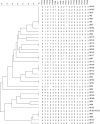Molecular typing of Mycobacterium abscessus based on tandem-repeat polymorphism
- PMID: 22760048
- PMCID: PMC3421802
- DOI: 10.1128/JCM.00753-12
Molecular typing of Mycobacterium abscessus based on tandem-repeat polymorphism
Abstract
A variable-number tandem-repeat (VNTR) typing assay for the differentiation of Mycobacterium abscessus strains was developed. This assay showed complete reproducibility, locus stability, and a discriminatory power (Hunter-Gaston discriminatory index [HGDI] of 0.9563) that is superior to that of multilocus sequencing. It is a promising tool for the investigation of Mycobacterium abscessus epidemiology and nosocomial outbreaks.
Figures


Similar articles
-
Mycobacterial genotypes are associated with clinical manifestation and progression of lung disease caused by Mycobacterium abscessus and Mycobacterium massiliense.Clin Infect Dis. 2013 Jul;57(1):32-9. doi: 10.1093/cid/cit172. Epub 2013 Mar 19. Clin Infect Dis. 2013. PMID: 23511298
-
Investigation of the population structure of Mycobacterium abscessus complex strains using 17-locus variable number tandem repeat typing and the further distinction of Mycobacterium massiliense hsp65 genotypes.J Med Microbiol. 2015 Mar;64(Pt 3):254-261. doi: 10.1099/jmm.0.000016. Epub 2015 Jan 16. J Med Microbiol. 2015. PMID: 25596119
-
[Genetic research about Mycobacterium avium complex].Kekkaku. 2011 Feb;86(2):61-8. Kekkaku. 2011. PMID: 21404652 Japanese.
-
Mycobacterium abscessus infection in cystic fibrosis: molecular typing and clinical outcomes.J Med Microbiol. 2014 Oct;63(Pt 10):1241-1246. doi: 10.1099/jmm.0.077164-0. Epub 2014 Aug 8. J Med Microbiol. 2014. PMID: 25106861 Review.
-
[New era in molecular epidemiology of tuberculosis in Japan].Kekkaku. 2006 Nov;81(11):693-707. Kekkaku. 2006. PMID: 17154049 Review. Japanese.
Cited by
-
Support from Phylogenomic Networks and Subspecies Signatures for Separation of Mycobacterium massiliense from Mycobacterium bolletii.J Clin Microbiol. 2015 Sep;53(9):3042-6. doi: 10.1128/JCM.00541-15. Epub 2015 Jul 8. J Clin Microbiol. 2015. PMID: 26157149 Free PMC article.
-
MGIT Enriched Shotgun Metagenomics for Routine Identification of Nontuberculous Mycobacteria: a Route to Personalized Health Care.J Clin Microbiol. 2023 Mar 23;61(3):e0131822. doi: 10.1128/jcm.01318-22. Epub 2023 Feb 22. J Clin Microbiol. 2023. PMID: 36840602 Free PMC article.
-
Highly Discriminative Genotyping of Mycobacterium abscessus Complex Using a Set of Variable Number Tandem Repeats in China.Front Microbiol. 2022 Jan 31;12:802133. doi: 10.3389/fmicb.2021.802133. eCollection 2021. Front Microbiol. 2022. PMID: 35173692 Free PMC article.
-
PCR amplification of the erm(41) gene can be used to predict the sensitivity of Mycobacterium abscessus complex strains to clarithromycin.Exp Ther Med. 2020 Feb;19(2):945-955. doi: 10.3892/etm.2019.8289. Epub 2019 Dec 5. Exp Ther Med. 2020. PMID: 32010256 Free PMC article.
-
High rate of macrolide resistance and closely genetically related Mycobacterium abscessus complex strains identified among both cystic fibrosis and non-cystic fibrosis patients within two countries.Microbiol Spectr. 2024 Oct 23;12(12):e0105624. doi: 10.1128/spectrum.01056-24. Online ahead of print. Microbiol Spectr. 2024. PMID: 39440987 Free PMC article.
References
-
- Adékambi T, Berger P, Raoult D, Drancourt M. 2006. rpoB gene sequence-based characterization of emerging non-tuberculous mycobacteria with descriptions of Mycobacterium bolletii sp. nov., Mycobacterium phocaicum sp. nov. and Mycobacterium aubagnense sp. nov. Int. J. Syst. Evol. Microbiol. 56:133–143 - PubMed
-
- Appelgren P, et al. 2008. Late-onset posttraumatic skin and soft-tissue infections caused by rapid-growing mycobacteria in tsunami survivors. Clin. Infect. Dis. 47:e11–e16 - PubMed
Publication types
MeSH terms
Substances
LinkOut - more resources
Full Text Sources
Molecular Biology Databases

